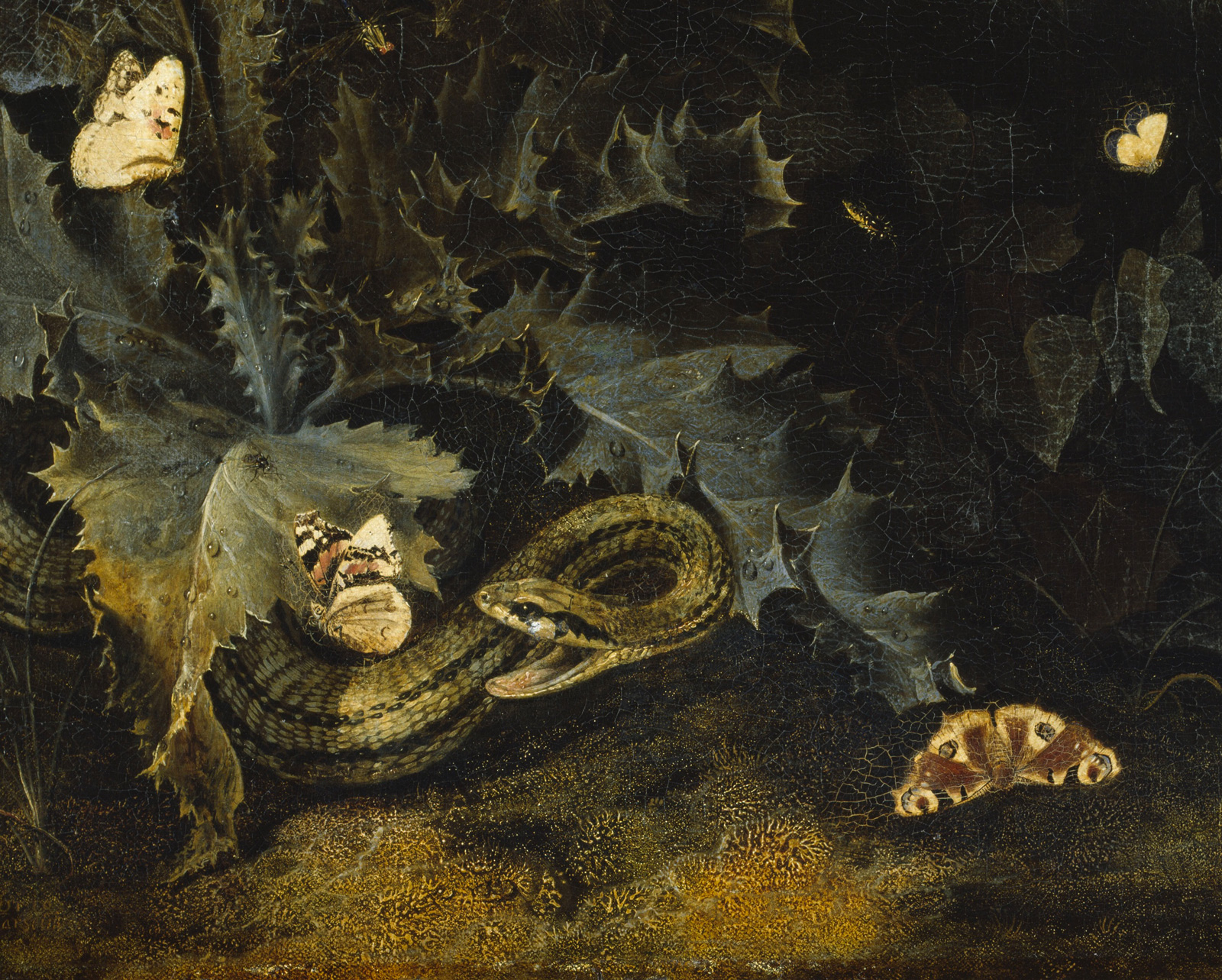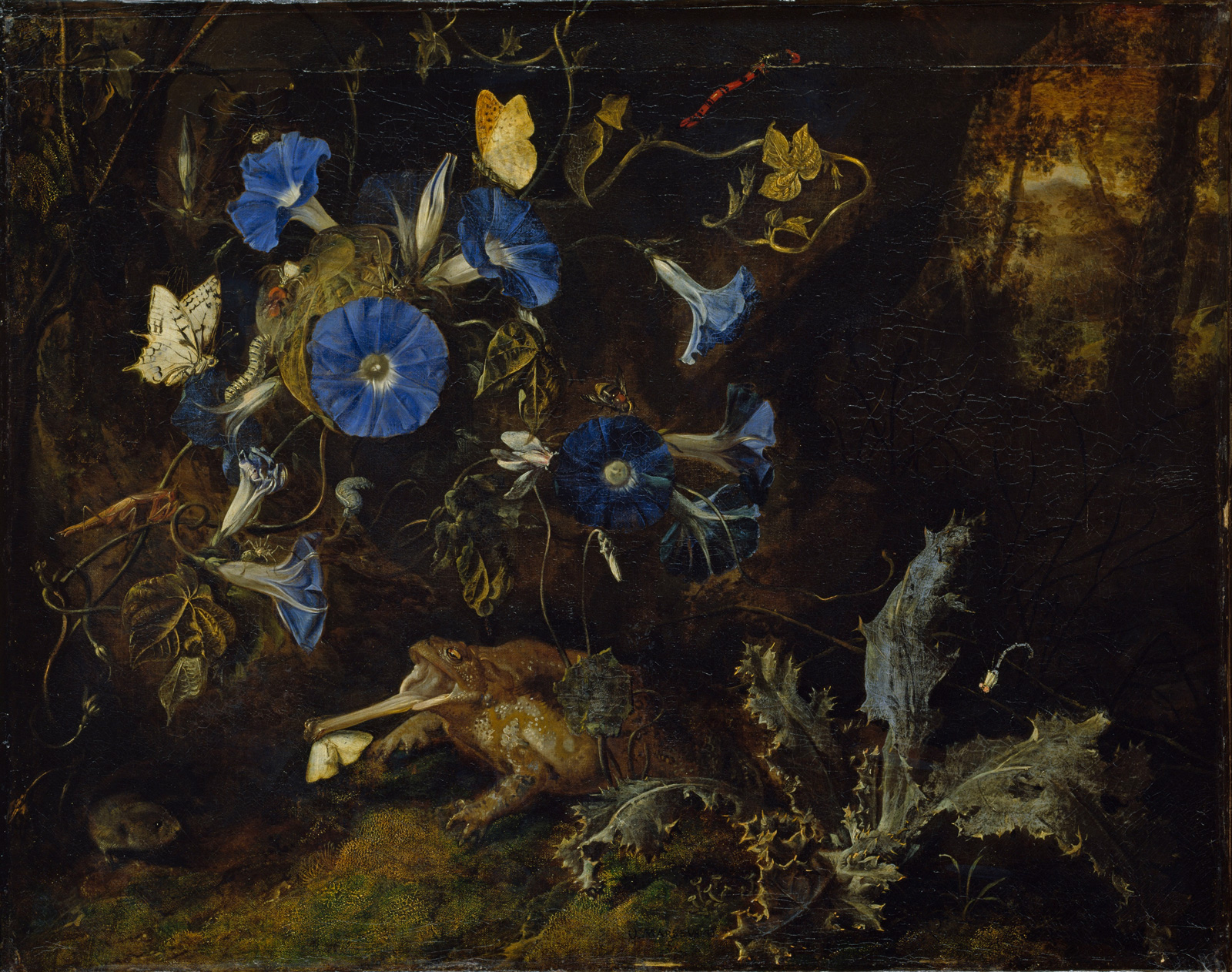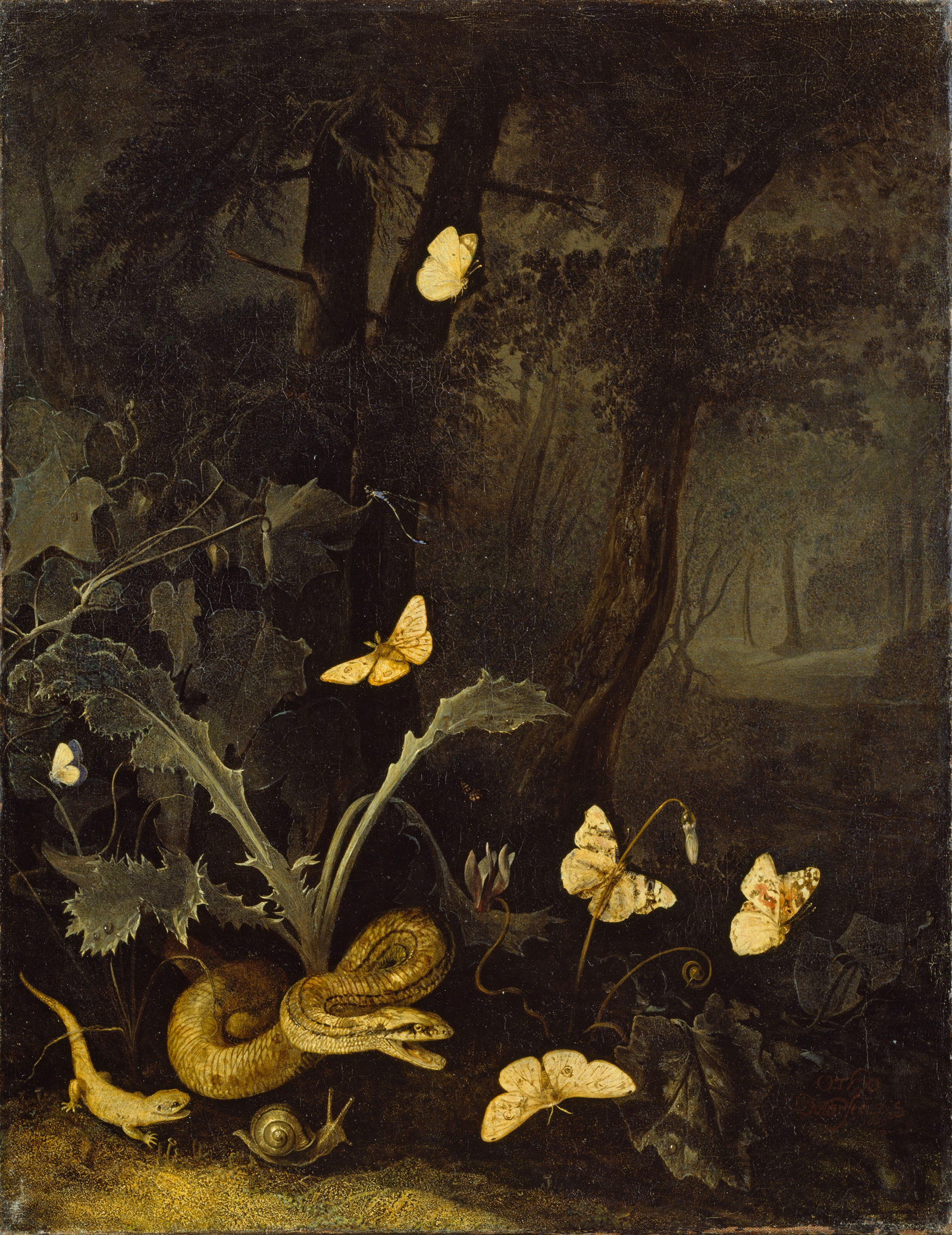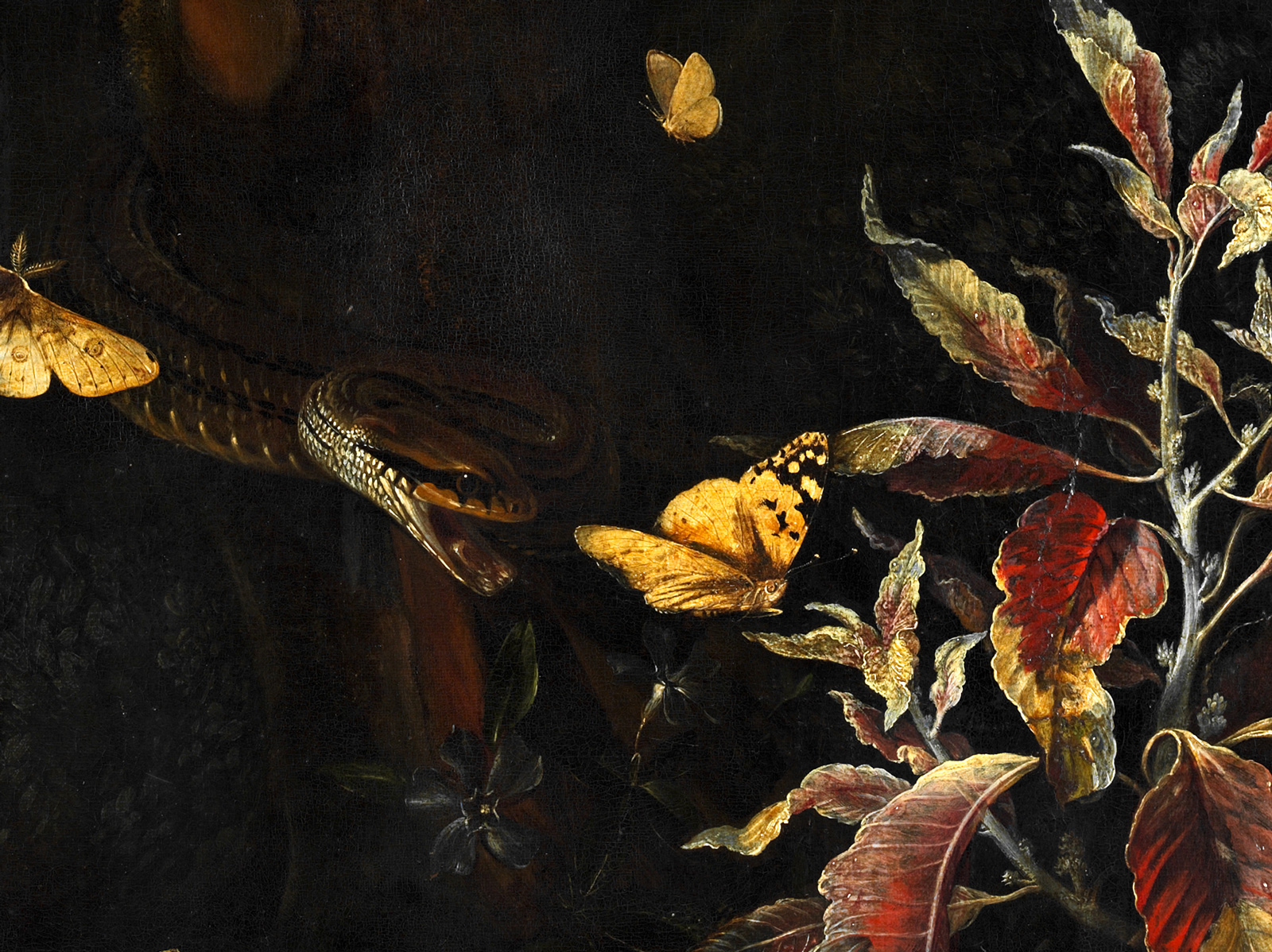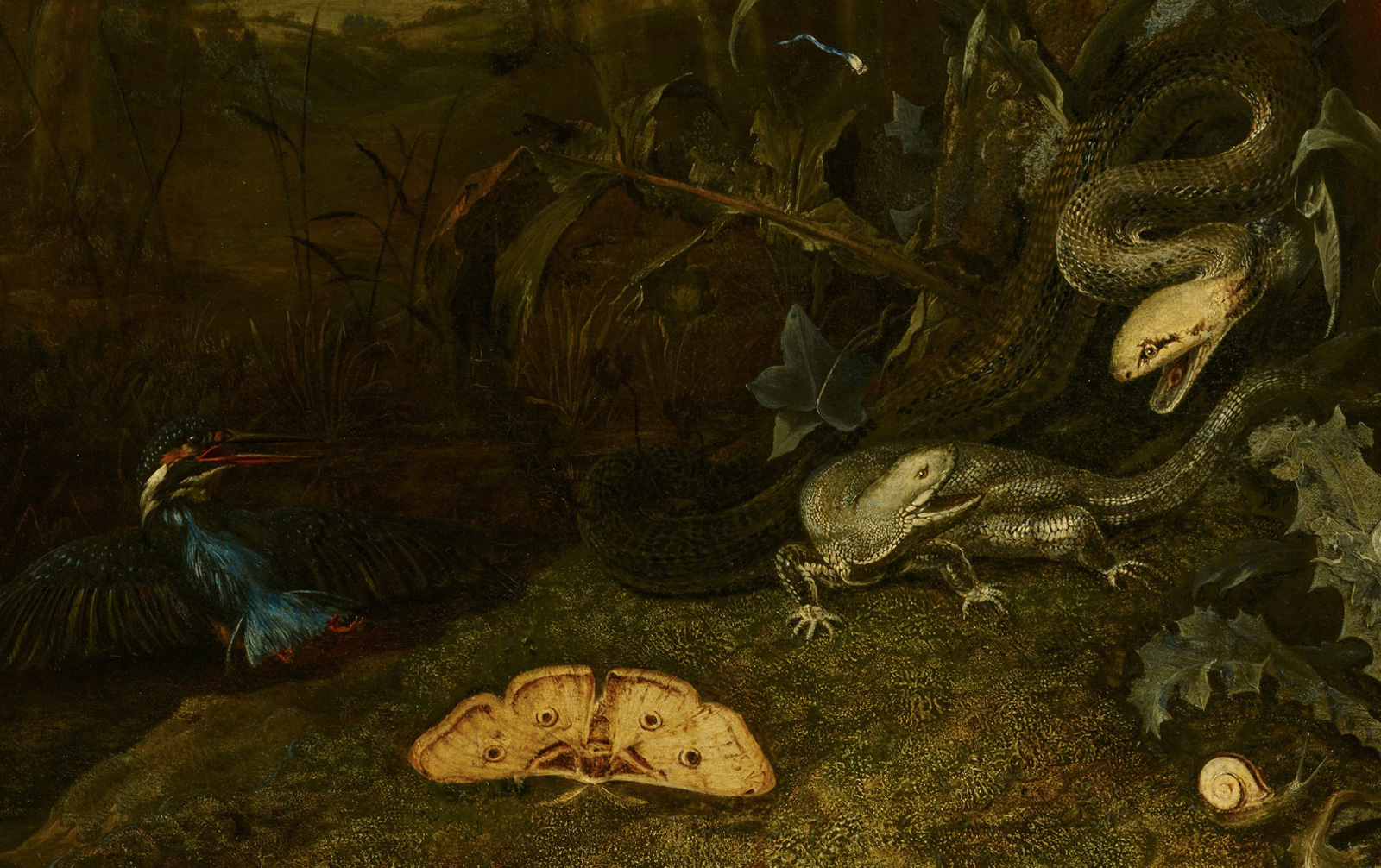For much of his life, the painter Otto Marseus van Schrieck (circa 1620-1678) lived beyond Amsterdam’s city walls in a marshy area known as “the land of snakes,” where he had a small country house. There, Marseus kept a menagerie of reptiles, insects, and vermin for the purposes of the peculiar genre of painting he had invented—his wife later claimed that he spent so much time handling the snakes that they eventually began posing for him—which was so much in demand that when Cosimo de Medici visited Amsterdam in 1667, Marseus, not Rembrandt, was the first person he received.
Medici had come in search of what later generations called the sottobosco, the forest-floor still life, Marseus’s eye-level portraits of the dark world of the underbrush and the creeping Lilliputian fauna that haunted it. His paintings brim with thistles, wild tulips, and ethereal white mushrooms, around which snails, snakes, salamanders, and toads go about their lives, all painted in expressive detail reminiscent of Hieronymus Bosch’s minutely observed scenes of the grotesque and exotic. Although today Marseus is almost entirely forgotten, a new show at the Rijksmuseum Twenthe gives us a sense not just of the weird, lush beauty of his paintings, but of how they straddled the worlds of art and science, reflecting the latest scientific developments during the Dutch Golden Age—particularly a newfound fascination with the infinitesimal—even as they were shaped by Marseus’s idiosyncratic artistic whims.
No one quite knows what led Marseus to the invention of the sottobosco, but it was certainly in the spirit of the times. Born around 1620, Marseus grew up amid the great scientific flourishing of the seventeenth century. This included, among much else, the development of the microscope, which soon led to a widespread enthusiasm for all things minute. Around when Marseus is thought to have been born, the poet and composer Constantijn Huygens looked through an early microscope, later marveling in his memoirs that, “It really is as if you stand before a new theater of nature, or are on a different planet.” The sentiment captures much of the joy of Marseus’s paintings, which at their best give the impression of seeing a world through the eyes of someone encountering it for the first time.
As two of the catalog’s excellent biographical essays (by Gero Seelig and Eric Jorink) tell us, at the same time that Marseus was developing his technique, fierce debates were going on over aspects of the Great Chain of Being, a hierarchical view of all elements of the known world that ran from God at the very top, down to humans, animals, plants, and, at the bottom, rocks. It had long been believed that snakes, toads, insects, mushrooms, and other low beings were generated spontaneously, whether from mud warmed by the sun, or from drops of rain, or even bales of hay. These lowly beings weren’t held in the highest esteem (the Bible warns: “Ye shall not make yourselves abominable with any creeping thing that creepeth, neither shall ye make yourselves unclean with them, that ye should be defiled thereby”), and were deemed insufficiently grand subjects for painting. In Amsterdam, however, Marseus ran in scientific circles that began to call these notions into doubt, noting, for instance, as Francesco Redi did, that flies actually hatch from eggs, not from putrid corpses or mud. There was therefore something daring and novel about Marseus’s subject.
Apart from a swashbuckling but often unreliable biography by Houbraken, we know relatively little about Marseus. He had been nicknamed the Sniffler (“de Snuffelaer”) while living and painting in Italy around the 1650s, apparently because of his propensity to sniff “about everywhere for strange colored and speckled snakes, lizards, caterpillars, spiders, butterflies, and strange plants and herbs.” While in Italy he was a member of the Bentvueghels, a hard-drinking society of Dutch and Flemish painters based in Rome (they are said to have given Marseus his nickname after he completed their alcohol-fueled initiation ceremony), and it was in Rome’s environs that he first went hunting for his diverse creatures and began to develop his distinctive version of the still life. He also came to the attention of the Medici, who, tiring of the near-constant poisonings in their court, hoped to develop an anti-venom serum through the study of vipers. Marseus’s paintings of poisonous snakes apparently appealed to them.
Marseus, as a budding man of science, sought a level of accuracy in depicting his plants and animals that even today can look impressively realistic. To achieve this, he sometimes used unorthodox techniques: some art historians suspect that he produced his reliefs of moss by daubing pigment with actual moss or sponge. When depicting butterflies, he pressed butterfly wings into the wet paint, embedding their scales into the canvas so that the insect’s natural iridescence became part of the work. In a particularly stunning detail in the catalog, one can see an enhancement of the scales, which even in the photo seem to emit a dull gleam.
Advertisement
At the same time, his paintings are full of imagined settings—plants and animals in places where they would never appear, behaving unnaturally. Snakes coil in physically impossible ways, constantly try to eat butterflies, and do battle with lizards, then thought to be their mortal enemies (something the seventeenth-century French apothecary Moyse Charas doubted, recording that, “Having thrown lizards alive into a barrel, wherein I keep a good number of living Vipers, and leaving them there whole days and nights, the Vipers did not hurt at all to the Lizards”). Others exhibit behavior that might not be technically impossible but nevertheless seems unlikely: a toad and salamander engaged in a tug-of-war over a butterfly while a snake and a lizard seem to cheer them on, or a lizard and a snail following gamely along behind a snake stalking an emperor moth.
The behavior of Marseus’s animals and insects shifts notably throughout his career, more or less in the form of a bell curve corresponding to rising and falling action. In one early painting, Landscape with Lizard, Butterflies, and Snail, dated to about 1657, when Marseus is thought to have been in Italy, the animals interact relatively little, the main action being a lizard looking wistfully at a butterfly suspended in the air above it. Another, Animals in a Grotto, shows a snake looking intently at a moth in the foreground, while in the distance a beautiful landscape unfolds, with a drover and his dog driving a cow across a meadow. But another painting dated to the same period, Landscape with Reptiles, Insects, Cyclamen, and Thistle, shows considerably more action. In it, an unfortunate lizard is attacked by a crayfish, its tail caught in one of the crustacean’s pincers as a snake slowly encircles it. Butterflies float in the air above as a handsome toad, like the mysterious stranger watching the magi in Bosch’s Epiphany, looks on from the margins.
As the years wear on, animals more and more take center stage. Still Life with Insects, Amphibians, and Reptiles (1662) is one of his most animated, and to many his masterpiece. The painting contains almost all of his favorite motifs: a trio of serpents, mushrooms ripe to the point of putrefaction, and a toad, his tongue lolling, squaring off against a lizard. The handsome toad makes another appearance in Three Snakes, Lizard, and Butterflies, gripping a butterfly in its mouth while the surviving butterflies flee upward, serving—as they do in all his pictures—almost as mobile flowers, beautiful bursts of light to draw the eye. As Marseus’s technique began to mature, plants took over as the focal point. The snake in Butterflies and Flowers (1675), coiled and ready to strike at an unsuspecting butterfly, nevertheless recedes into the background, upstaged by the spotlit plant. Marseus does more with less in these paintings, and they are undoubtedly, in the words of Gero Seelig, “quieter but more effective compositions.” For all that, they seem to lack some of the excitement and youthful enthusiasm of his earlier works.
An excellent catalog essay by Karin Leonhard considers the possible meaning and significance of the motifs in Marseus’s works, focusing particularly on what she calls the dualistic principles that might explain some of the less natural behavior found in these paintings—conflicting elements of air (the salamander), earth (the frog), and fire (the lizard); or the battle between the spirit (the butterfly, whose name in ancient Greek, psyche, also means soul) with material forces like the toad or the snake. Yet it is just as fascinating, as Seelig notes in a short essay, that Marseus so often focused on toads and snakes—animals so variously replete with Biblical, mythological, and pseudo-medicinal significance—while at the same time never depicting them in an overtly allegorical way. They simply appear in their environments, sometimes acting naturally, sometimes not. It is part of the charm of these paintings that they are as much works of Marseus’s imagination as of scientific observation. This is what is so beguiling about his art—one can see in it changing modes of thought at work, a gradual groping toward a world of scientific accuracy, even as the arrangement of the lush, unearthly plants and the animals, with their wonderful, quizzical expressiveness, seems to spring from the mind of the painter, presented for maximum visual appeal and delight.
Advertisement
“Otto Marseus van Schrieck (ca. 1620 -1678)” is at the Rijksmuseum Twenthe in Enschede, Netherlands, through March 11, 2018. The English edition of the accompanying book, Medusa’s Menagerie: Otto Marseus van Schrieck and the Scholars—which is edited by Gero Seelig and the Staatliches Museum Schwerin, published by Hirmer and distributed by University of Chicago Press—is forthcoming.


